MovingMNIST in PyTorch
Buy Me a Coffee☕
*My post explains Moving MNIST.
MovingMNIST() can use Moving MNIST dataset as shown below:
*Memos:
- The 1st argument is root(Required-Type:str or pathlib.Path). *An absolute or relative path is possible.
- The 2nd argument is split(Optional-Default:None-Type:str):
*Memos:
- None, "train" or "test" can be set to it.
- If it's None, all 20 frames(images) of each video are returned, ignoring split_ratio.
- The 3rd argument is split_ratio(Optional-Default:10-Type:int):
*Memos:
- If split is "train", data[:, :split_ratio] is returned.
- If split is "test", data[:, split_ratio:] is returned.
- If split is None, it's ignored. ignoring split_ratio.
- The 4th argument is transform(Optional-Default:None-Type:callable).
- The 5th argument is download(Optional-Default:False-Type:bool):
*Memos:
- If it's True, the dataset is downloaded from the internet to root.
- If it's True and the dataset is already downloaded, it's extracted.
- If it's True and the dataset is already downloaded, nothing happens.
- It should be False if the dataset is already downloaded because it's faster.
- You can manually download and extract the dataset from here to e.g. data/MovingMNIST/.
from torchvision.datasets import MovingMNIST
all_data = MovingMNIST(
root="data"
)
all_data = MovingMNIST(
root="data",
split=None,
split_ratio=10,
download=False,
transform=None
)
train_data = MovingMNIST(
root="data",
split="train"
)
test_data = MovingMNIST(
root="data",
split="test"
)
len(all_data), len(train_data), len(test_data)
# (10000, 10000, 10000)
len(all_data[0]), len(train_data[0]), len(test_data[0])
# (20, 10, 10)
all_data
# Dataset MovingMNIST
# Number of datapoints: 10000
# Root location: data
all_data.root
# 'data'
print(all_data.split)
# None
all_data.split_ratio
# 10
all_data.download
# <bound method MovingMNIST.download of Dataset MovingMNIST
# Number of datapoints: 10000
# Root location: data>
print(all_data.transform)
# None
from torchvision.datasets import MovingMNIST
import matplotlib.pyplot as plt
plt.figure(figsize=(10, 3))
plt.subplot(1, 3, 1)
plt.title("all_data")
plt.imshow(all_data[0].squeeze()[0])
plt.subplot(1, 3, 2)
plt.title("train_data")
plt.imshow(train_data[0].squeeze()[0])
plt.subplot(1, 3, 3)
plt.title("test_data")
plt.imshow(test_data[0].squeeze()[0])
plt.show()
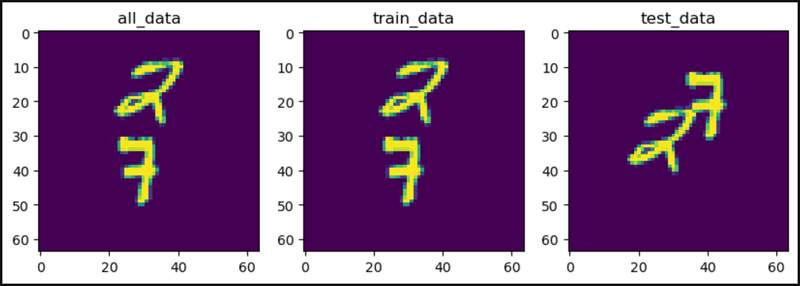
from torchvision.datasets import MovingMNIST
all_data = MovingMNIST(
root="data",
split=None
)
train_data = MovingMNIST(
root="data",
split="train"
)
test_data = MovingMNIST(
root="data",
split="test"
)
def show_images(data, main_title=None):
plt.figure(figsize=(10, 8))
plt.suptitle(t=main_title, y=1.0, fontsize=14)
for i, image in enumerate(data, start=1):
plt.subplot(4, 5, i)
plt.tight_layout(pad=1.0)
plt.title(i)
plt.imshow(image)
plt.show()
show_images(data=all_data[0].squeeze(), main_title="all_data")
show_images(data=train_data[0].squeeze(), main_title="train_data")
show_images(data=test_data[0].squeeze(), main_title="test_data")
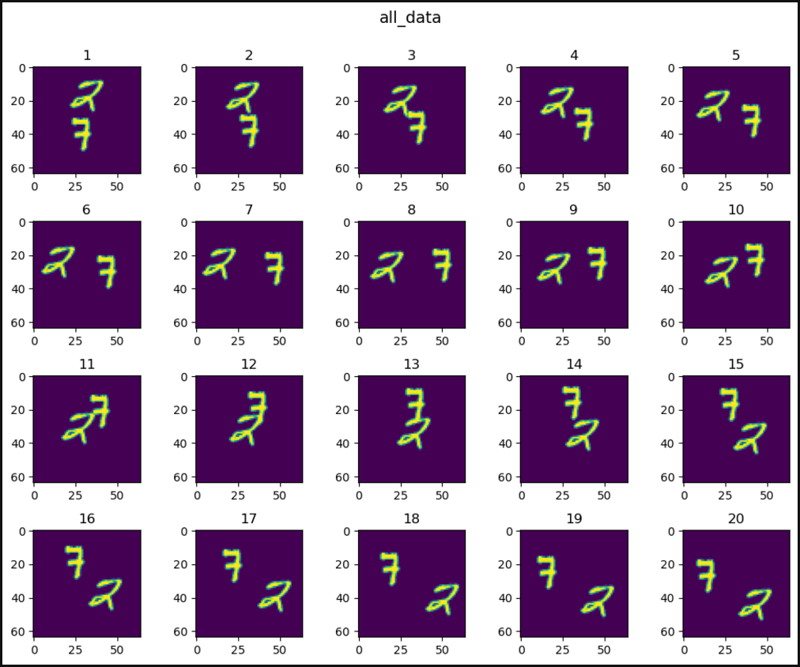

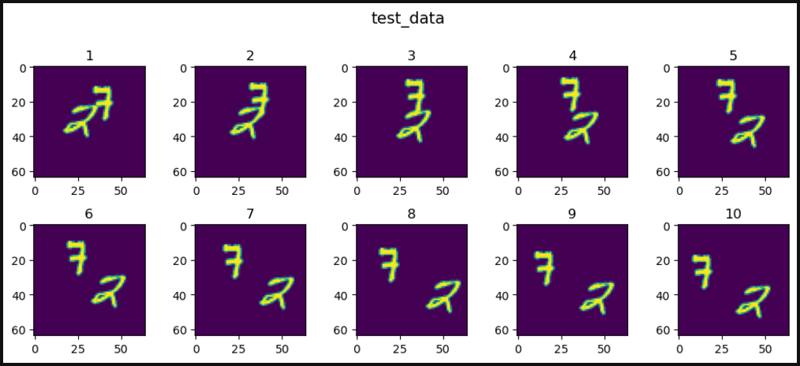
from torchvision.datasets import MovingMNIST
all_data = MovingMNIST(
root="data",
split=None
)
train_data = MovingMNIST(
root="data",
split="train"
)
test_data = MovingMNIST(
root="data",
split="test"
)
import matplotlib.pyplot as plt
def show_images(data, main_title=None):
plt.figure(figsize=(10, 8))
plt.suptitle(t=main_title, y=1.0, fontsize=14)
col = 5
for i, image in enumerate(data, start=1):
plt.subplot(4, 5, i)
plt.tight_layout(pad=1.0)
plt.title(i)
plt.imshow(image.squeeze()[0])
if i == col:
break
plt.show()
show_images(data=all_data, main_title="all_data")
show_images(data=train_data, main_title="train_data")
show_images(data=test_data, main_title="test_data")

from torchvision.datasets import MovingMNIST
import matplotlib.animation as animation
all_data = MovingMNIST(
root="data"
)
import matplotlib.pyplot as plt
from IPython.display import HTML
figure, axis = plt.subplots()
# ↓ ↓ ↓ ↓ ↓ ↓ ↓ ↓ ↓ ↓ `ArtistAnimation()` ↓ ↓ ↓ ↓ ↓ ↓ ↓ ↓ ↓ ↓
images = []
for image in all_data[0].squeeze():
images.append([axis.imshow(image)])
ani = animation.ArtistAnimation(fig=figure, artists=images,
interval=100)
# ↑ ↑ ↑ ↑ ↑ ↑ ↑ ↑ ↑ ↑ `ArtistAnimation()` ↑ ↑ ↑ ↑ ↑ ↑ ↑ ↑ ↑ ↑
# ↓ ↓ ↓ ↓ ↓ ↓ ↓ ↓ ↓ `FuncAnimation()` ↓ ↓ ↓ ↓ ↓ ↓ ↓ ↓ ↓
# def animate(i):
# axis.imshow(all_data[0].squeeze()[i])
#
# ani = animation.FuncAnimation(fig=figure, func=animate,
# frames=20, interval=100)
# ↑ ↑ ↑ ↑ ↑ ↑ ↑ ↑ ↑ `FuncAnimation()` ↑ ↑ ↑ ↑ ↑ ↑ ↑ ↑ ↑
# ani.save('result.gif') # Save the animation as a `.gif` file
plt.ioff() # Hide a useless image
# ↓ ↓ ↓ ↓ ↓ ↓ ↓ ↓ Show animation ↓ ↓ ↓ ↓ ↓ ↓ ↓ ↓
HTML(ani.to_jshtml()) # Animation operator
# HTML(ani.to_html5_video()) # Animation video
# ↑ ↑ ↑ ↑ ↑ ↑ ↑ ↑ Show animation ↑ ↑ ↑ ↑ ↑ ↑ ↑ ↑
# ↓ ↓ ↓ ↓ ↓ ↓ ↓ ↓ ↓ ↓ ↓ ↓ Show animation ↓ ↓ ↓ ↓ ↓ ↓ ↓ ↓ ↓ ↓ ↓ ↓
# plt.rcParams["animation.html"] = "jshtml" # Animation operator
# plt.rcParams["animation.html"] = "html5" # Animation video
# ↑ ↑ ↑ ↑ ↑ ↑ ↑ ↑ ↑ ↑ ↑ ↑ Show animation ↑ ↑ ↑ ↑ ↑ ↑ ↑ ↑ ↑ ↑ ↑ ↑
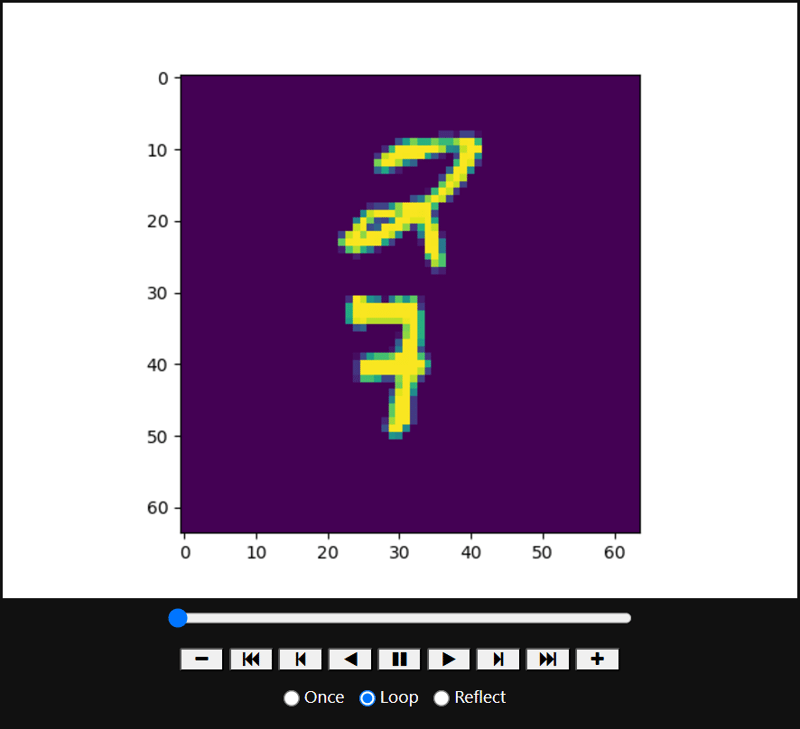
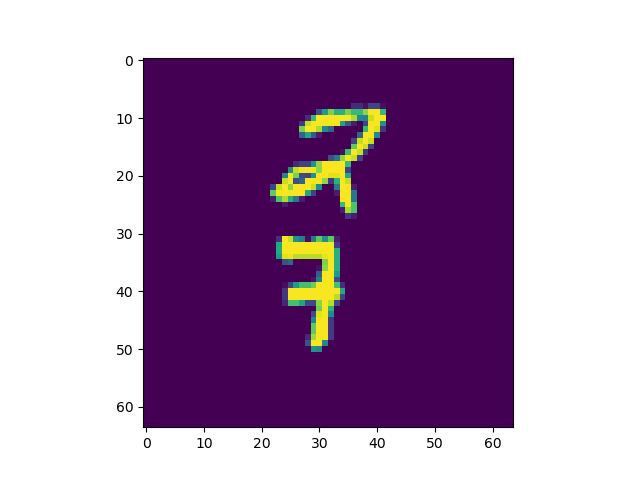
from torchvision.datasets import MovingMNIST
from ipywidgets import interact, IntSlider
all_data = MovingMNIST(
root="data"
)
import matplotlib.pyplot as plt
from IPython.display import HTML
def func(i):
plt.imshow(all_data[0].squeeze()[i])
interact(func, i=(0, 19, 1))
# interact(func, i=IntSlider(min=0, max=19, step=1, value=0))
# ↑ ↑ ↑ ↑ ↑ ↑ ↑ ↑ ↑ ↑ Set the start value ↑ ↑ ↑ ↑ ↑ ↑ ↑ ↑ ↑ ↑
plt.show()
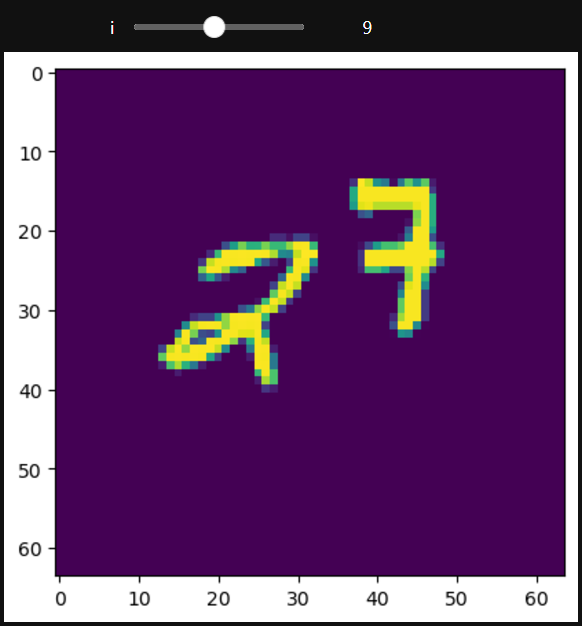
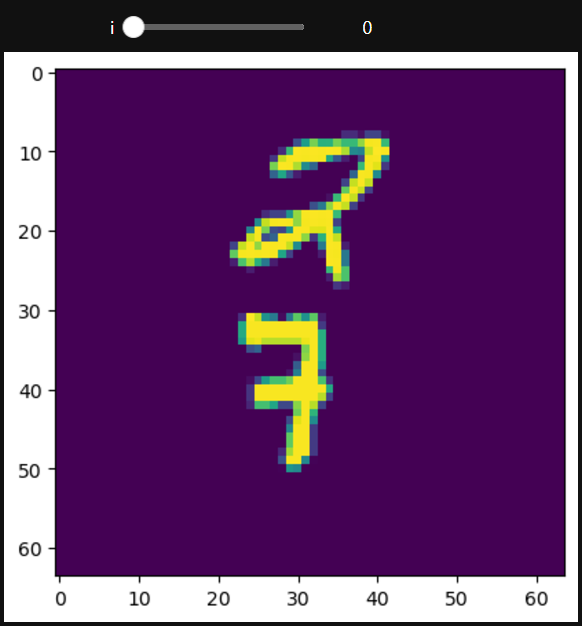
The above is the detailed content of MovingMNIST in PyTorch. For more information, please follow other related articles on the PHP Chinese website!

Hot AI Tools

Undresser.AI Undress
AI-powered app for creating realistic nude photos

AI Clothes Remover
Online AI tool for removing clothes from photos.

Undress AI Tool
Undress images for free

Clothoff.io
AI clothes remover

Video Face Swap
Swap faces in any video effortlessly with our completely free AI face swap tool!

Hot Article

Hot Tools

Notepad++7.3.1
Easy-to-use and free code editor

SublimeText3 Chinese version
Chinese version, very easy to use

Zend Studio 13.0.1
Powerful PHP integrated development environment

Dreamweaver CS6
Visual web development tools

SublimeText3 Mac version
God-level code editing software (SublimeText3)

Hot Topics
 How to avoid being detected by the browser when using Fiddler Everywhere for man-in-the-middle reading?
Apr 02, 2025 am 07:15 AM
How to avoid being detected by the browser when using Fiddler Everywhere for man-in-the-middle reading?
Apr 02, 2025 am 07:15 AM
How to avoid being detected when using FiddlerEverywhere for man-in-the-middle readings When you use FiddlerEverywhere...
 How to handle comma-separated list query parameters in FastAPI?
Apr 02, 2025 am 06:51 AM
How to handle comma-separated list query parameters in FastAPI?
Apr 02, 2025 am 06:51 AM
Fastapi ...
 How to solve permission issues when using python --version command in Linux terminal?
Apr 02, 2025 am 06:36 AM
How to solve permission issues when using python --version command in Linux terminal?
Apr 02, 2025 am 06:36 AM
Using python in Linux terminal...
 How to teach computer novice programming basics in project and problem-driven methods within 10 hours?
Apr 02, 2025 am 07:18 AM
How to teach computer novice programming basics in project and problem-driven methods within 10 hours?
Apr 02, 2025 am 07:18 AM
How to teach computer novice programming basics within 10 hours? If you only have 10 hours to teach computer novice some programming knowledge, what would you choose to teach...
 Python asyncio Telnet connection is disconnected immediately: How to solve server-side blocking problem?
Apr 02, 2025 am 06:30 AM
Python asyncio Telnet connection is disconnected immediately: How to solve server-side blocking problem?
Apr 02, 2025 am 06:30 AM
About Pythonasyncio...
 How to get news data bypassing Investing.com's anti-crawler mechanism?
Apr 02, 2025 am 07:03 AM
How to get news data bypassing Investing.com's anti-crawler mechanism?
Apr 02, 2025 am 07:03 AM
Understanding the anti-crawling strategy of Investing.com Many people often try to crawl news data from Investing.com (https://cn.investing.com/news/latest-news)...
 Python 3.6 loading pickle file error ModuleNotFoundError: What should I do if I load pickle file '__builtin__'?
Apr 02, 2025 am 06:27 AM
Python 3.6 loading pickle file error ModuleNotFoundError: What should I do if I load pickle file '__builtin__'?
Apr 02, 2025 am 06:27 AM
Loading pickle file in Python 3.6 environment error: ModuleNotFoundError:Nomodulenamed...
 What is the reason why pipeline files cannot be written when using Scapy crawler?
Apr 02, 2025 am 06:45 AM
What is the reason why pipeline files cannot be written when using Scapy crawler?
Apr 02, 2025 am 06:45 AM
Discussion on the reasons why pipeline files cannot be written when using Scapy crawlers When learning and using Scapy crawlers for persistent data storage, you may encounter pipeline files...






